The iliopsoas contributes heavily to Olympic lifts and every day activities like walking and running. It also influences our form in many other types of movement, depending on how weak or how tight this group of muscles may be.
This article will give you a better understanding of the importance of the iliopsoas muscle group, how to strengthen it, and how to lengthen it for those who are tight in this area.
The Muscles That Make Up the Iliopsoas
The two muscles that make up the iliopsoas group are the psoas major and iliacus. These two muscles are important in the hip flexor group and as low back stabilizers. In fact, the iliopsoas is one of the most powerful of the hip flexor group. There is a possible third muscle, which some of us have and some of us don’t, that I will address, as well.
Muscular Anatomy of the Iliopsoas
Psoas Major: This muscle is deep to the abdominal contents
- Action: At the coxal joint, it flexes, laterally rotates, and adducts the hip
- Origin Site: Bodies and transverse processes of the lumbar vertebrae
- Insertion Site: Lesser trochanter
- Nerve Innervation: Lumbar plexus
Iliacus: Deep to the abdomen in the iliac fossa
- Action: Same as the psoas major
- Origin Site: Iliac fossa
- Insertion Site: Lesser trochanter
- Nerve Innervation: Femoral
Psoas Minor: Roughly 40% of the population has a psoas minor. Interestingly, the psoas minor is an important muscle of the locomotion in a dog or a cat, but in a human biped it is a relatively insignificant muscle.
- Action: Assist to create lordotic curve in the lumbar spine and tilt the pelvis posteriorly
- Origin Site: Body and transverse processes of the first lumbar vertebrae
- Insertion Site: Superior ramus of the pubis
- Nerve Innervation: Ventral rami of the lumbar
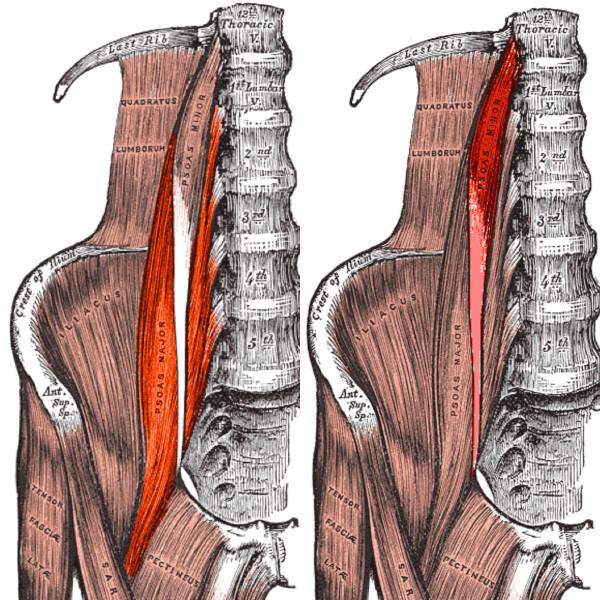
Iliopsoas Weakness
Iliopsoas weakness may result in a “sway back” posture or “flat back” posture. As the line of gravity falls slightly posterior to the hip axis, it creates an extension moment at the hip. EMG studies have shown that in normal conditions the iliopsoas muscle is activated to create an internal flexion moment to counteract this external force. Prolonged hyperextension resulting from this sway back posture increases stress placed on the anterior hip joint ligaments and anterior joint capsule, which can lead to instability in the hip joint. This can also cause muscle imbalances due to overcompensation of surrounding muscle tissue.
Iliopsoas Weakness and Your Sport
Weakness in the iliopsoas causes decreased ability to flex the hip joint, as well as difficulty bringing the trunk forward when preparing to rise up from a seated position or walk up an incline. If you are a runner, it decreases your stride pattern.
How this can impact our weightlifting can be explained by looking at the snatch lift. Many have heard of the “power triangle” in weightlifting – in this position the hips are flexed and the trunk is forward. With weak iliopsoas muscles you will have difficulty getting into this position, which means you lose out on potential power you can create in this area. So, you may not make gains you would like in the lift. Iliopsoas weakness also causes instability at the squat portion of these lifts, which can cause discomfort to the athlete.
How to Strengthen the Iliopsoas
Strengthening the iliopsoas can improve speed, agility, and strength in Olympic lifting movements. You can do any of these basic exercises before your workout or even after:
Leg Lifts
Lie on your back, legs extended in front of you. Place your hands either underneath your bottom or above your head. If your hands are above your head, be conscious about leaving your lower back on the ground rather than curved. Best way to do this is to think about bringing your belly button towards the spine. Lift one leg several inches above the ground. Do ten to fifteen reps on each leg. You can do these weighted.

Hanging Leg Lifts (Knee to Elbows)
Hang from a pull up bar. Lift both knees in towards the chest. It’s important to reach the knees to the chest area, or you can aim for your elbows like the knee to elbow movement.
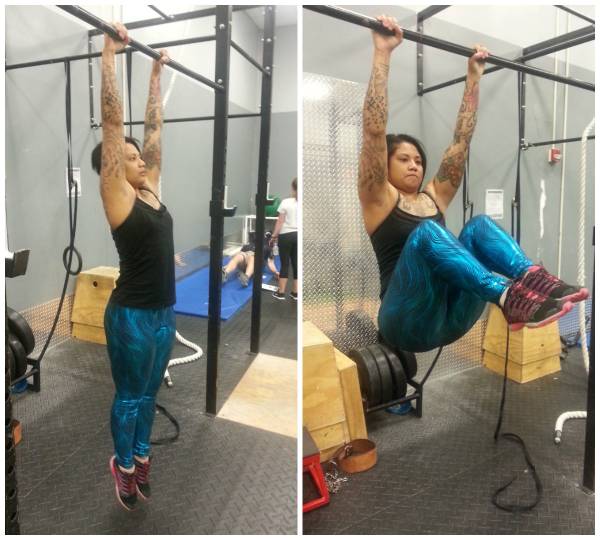
V-Sit
Start lying down. Lift the lower legs, knees bent at ninety degrees. Place the hands on the shins and begin to lift the upper body. Try to release the hands forward on the sides of each leg. If the strength is there, lift both legs upwards rather than forward. Hold for ten to fifteen seconds, for ten reps.
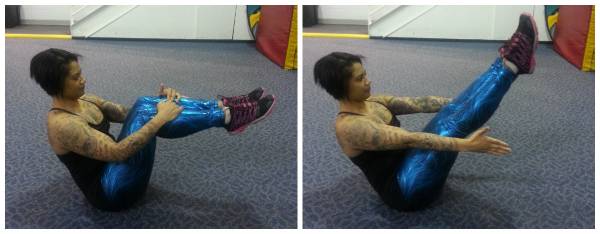
Bringing Length Into the Iliopsoas
Tight iliopsoas can be associated with low back discomfort and dysfunction because the muscles pull on the pelvis and affect range of motion in the low back and hips. Use these movements to help bring length to the area:
Low Lunge
We all know what a lunge position is. Remember to keep the bent knee at ninety degrees and lower the back leg towards the group. Lift the upper body. You want to shift your energy forward rather than backwards. If you would like you can lift your hands up towards the ceiling and add a little backbend to this movement to increase the stretch.
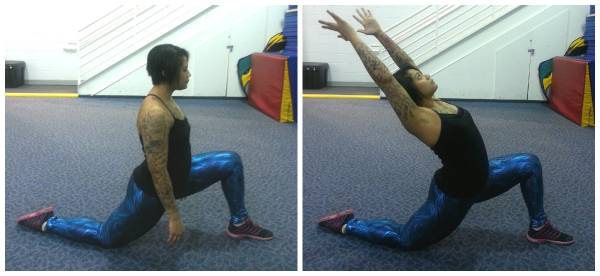
Bridge
Start lying down. Bend your knees so your feet are close to your glutes. Begin to lift the pelvis by squeezing the glutes and hamstrings. You hands should be by your side.

Inclined Plane or Reverse Plank
Begin in a seated position. Arms are behind the body and fingers are forward towards your feet. Activate the glutes and hamstrings and begin to lift the pelvis. This action will straighten your arms. The lower legs should be bent at a ninety-degree angle at the knees. If you feel comfortable in this position, extend the knees so both legs are extended forward. See if you can hold this position for thirty seconds to one minute.
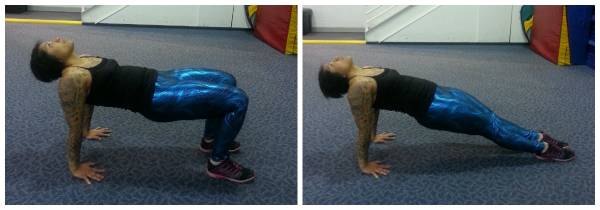
A healthy iliopsoas is important for all the movements that you do in daily life. So, it is vital you take the time to strengthen and lengthen these muscles to get the most out of your workouts and to prevent injuries. If you run into serious problems such as pain in the iliopsoas (which can manifest as low back pain or hip pain), then seeing a physical therapist or a massage therapist can help alleviate those problems and fix any resulting gait problems you may have developed, as well.
References:
1. Biel, Andrew. Trail Guide to the Body (Colorado: Books of Discovery, 2005), 328-330
2. Micheli, Lyle J. The Sports Medicine Bible (New York: Harper Collins, 1995), 60-63
3. Long, Ray. The Key Poses of Yoga (New York: Bandha Yoga Publications, 2008), 42-44
4. Long, Ray. Yoga Mat Companion 3: Anatomy for Backbends and Twists (New York: Bandha Yoga Publications, 2010), 164-168
5. Avila, Jessilynn and McArthur Kelly. “Extreme Weakness of the Iliopsoas.” Florida International University (2013): eFirst, accessed April 8, 2014.
Animation by Anatomography (en:Anatomography (setting page of this image)) [CC-BY-SA-2.1-jp], via Wikimedia Commons.






